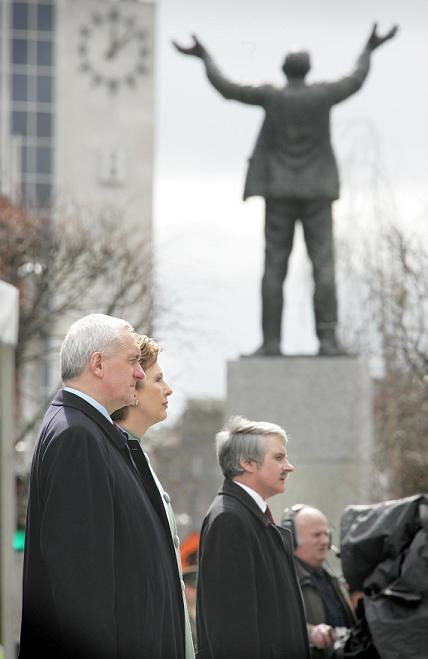
Donal Fallon looks ahead to the upcoming decade of centenaries and wonders how and who they will be celebrated by.
There has been a lot written in the mainstream media about the ‘decade of centenaries’ which the island, has entered. While much was made of last year’s royal visit to the Republic, one hundred years after the visit of George V in 1911, this year and the years ahead see the hundred year anniversaries of the Ulster Solemn League and Covenant, the foundation of the Labour Party, the Lockout of 1913, World War I and the Easter Rising.
These centenaries offer great opportunities in many regards. The anniversary of the Great War in particular is a chance for both communities on the island to re-examine that period and the conflict in which so many Irishmen perished as a result of ‘economic conscription’ and other factors.
However, it has become clear in recent years that the marking of historical anniversaries in Ireland remains very much a ‘top-down’ affair, with the State keen to remove any political element from proceedings. The folk singer Liam Weldon sang that “charlatans wear dead men’s shoes, aye and rattle dead men’s bones.” There has long been a tug-of-war in Irish political life for the legacy of historical icons, not least the towering figure of James Connolly.
Speaking at the launch of Connolly’s collected writings last year, Tánaiste Eamon Gilmore quoted his comments on the role of his Socialist Party of 1911. That party, Connolly said, “recognises that national political freedom is an inevitable step towards the attainment of universal economic freedom.”
Gilmore went on to say that “One hundred years later, almost to the week, the Labour Party entered a national Government with the simple aim of regaining Ireland’s economic sovereignty, so that we can go on to build a better society, and a future for our children.” Such an attempt to invoke an historical legacy for contemporary politics is by no means a new occurrence.
The 2006 Easter military parade on O’ Connell Street marked the first such parade in almost 30 years, with Bertie Ahern presiding as Taoiseach at the General Post Office. Yet it’s not clear that such a lavish display of military force was the best way to commemorate the Easter Rising, and it was a sad irony that 16 Moore Street stood rotting a minute’s walk from the GPO.
The important issue of preservation of historic sites linked to the events of 100 years ago also emerges when we discuss how to mark these centenaries. While leading politicians such as Gay Mitchell and Minister for Arts Jimmy Deenihan have toured the site around Moore Street, the relatives of the leaders of the 1916 Rising have found themselves in discussion with NAMA over the future of the Moore Street site. Developer Joe O’Reilly, whose companies are believed to owe close to €3 billion, is behind proposals which would see a nationally historic area reduced to rubble.
O’Reilly’s plans to ‘incorporate’ 16 Moore Street into a major renovation of the area were rightly met with anger by many. But it’s the inaction of successive governments that has allowed the building to fall into its present condition. Former Lord Mayor Gerry Breen of Fine Gael captured the attitude of the political establishment when he said that he supported the supposed renovation as “I come from a business background”, wondering “how relevant is 1916 to the Facebook generation?”

There is a strong need for grassroots organisations to mark many of the centenaries differently to the State, looking at the political questions concerning the period. An example of this is the North Inner City Folklore Project, which organises annual events inside that community through the unveiling of historic plaques, and has also produced pamphlets on issues such as ‘The Forgotten Women’ of the revolutionary period. Most importantly, this project engages with the youth of the North inner-city, involving them in the celebrations of anniversaries. Such community participation should be key in organising around the next decade of events.
The centenary of the 1913 Lockout will be of particular significance to those of us on the Left, and commemoration of it should be led by working class organisations. At the recent launch of a set of plaques on Emmet Road in Inchicore to commemorate Michael Mallin and William Partridge of the Irish Citizens’ Army, local TDs were invited to speak. Joan Collins of the United Left Alliance pointed out that many of the objectives of the labour movement of 1913 are still unaccomplished, but Government TDs also spoke, attempting to dilute any political element in the proceedings. Remembering our history is pivotal, but learning from and applying those lessons today is equally important. We will still be fighting many of the same battles in 2013.
The State holds little regard for the historical heritage of the island, ex- cept when it sees potential political capital in the marking of events. This is what led sites like Kilmainham Jail in years gone by and 16 Moore Street today to near ruin, and this is also the reason why events like World War 1, the Easter Rising and the 1913 Lockout will not be examined by the State in an appropriate manner. It is the task of those on the Left to organise inclusive debates, educational programmes and discussions among all on this island around upcoming centenaries.




